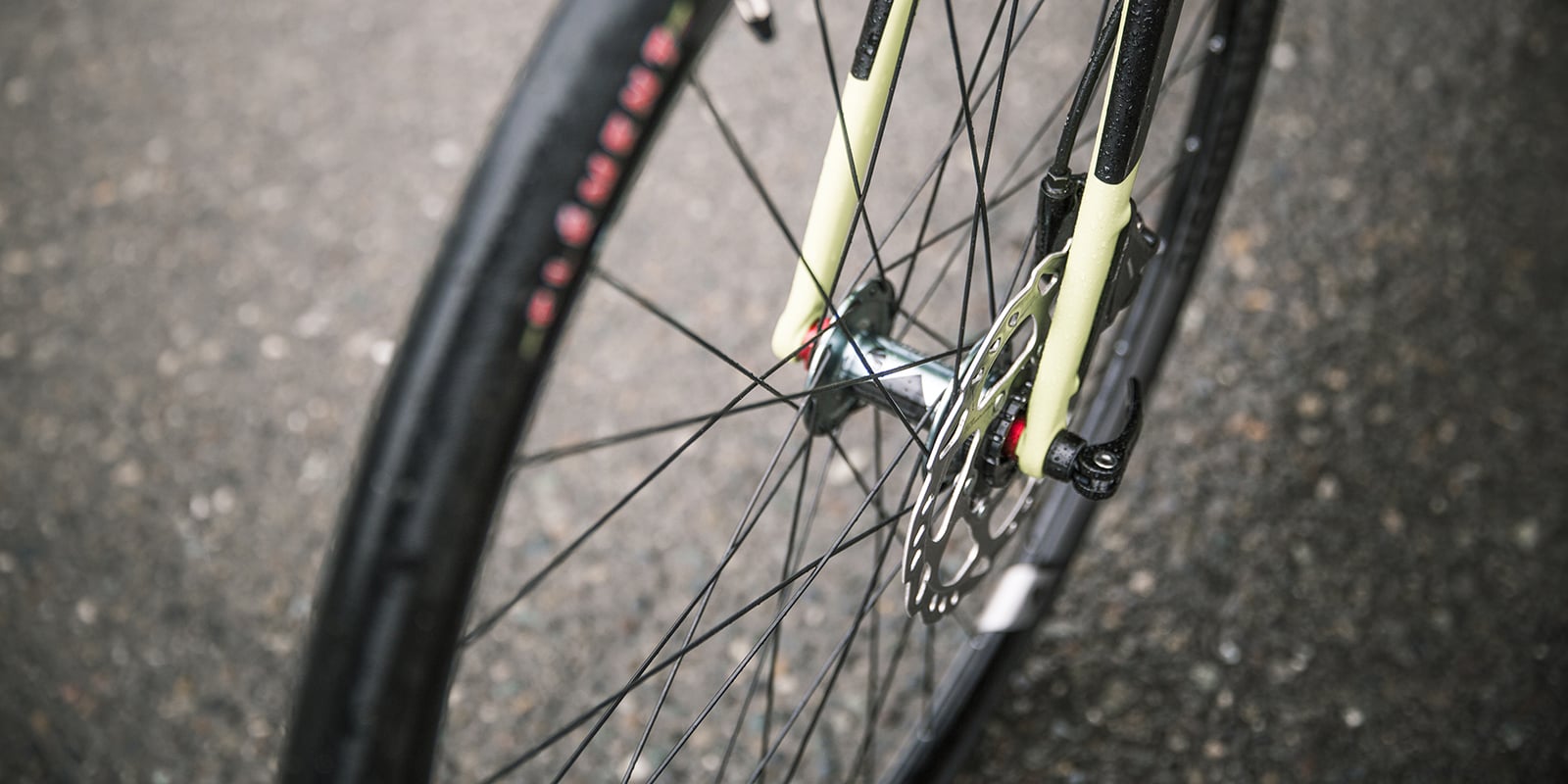After you've ridden your bike long enough, your wheels reach a point where they need to be replaced. Replacement mileage might vary from a few thousand miles to 20,000 miles or more, depending on your road or trail conditions, your weight, how much overall weight your bike is carrying, how aggressively you ride and, most importantly, how much braking you do.
When to replace your wheels: Some rims have a replacement indicator, a hole or groove that slowly disappears as the rim wears down. If your rim doesn't have a wear indicator, you can check the rim surface for a slight concave depression or other signs of excessive wear.
Rims and spokes are also subject to metal fatigue eventually, so you should ask the bike shop to assess your wheels' health if you've been riding on them for several years.
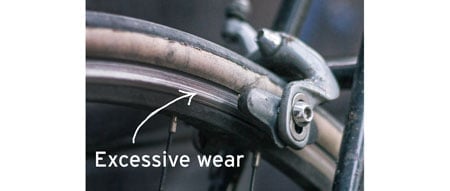
Consider upgrading your wheels to give yourself a performance boost. A wheel upgrade can help you ride faster, climb more efficiently or tackle downhill terrain more aggressively.
You might even consider custom wheel building. While this can be your most expensive option, it allows you to choose each component of the wheel individually. It also lets you precisely match your wheels to your riding needs.
Bike Wheel Compatibility
Whether you're replacing your current wheel because of rim wear or an encounter with a giant pothole, be sure your new wheel is compatible with your current bike setup in several areas.
To start, know that wheels are front- and rear-specific and you must match road tires to road wheels and mountain bike tires to mountain bike wheels. Then, look for the following:
Tire Dimensions
Look at the sidewall of your tire to find the tire size that will correspond with your new wheel size.
On road bike tires, you'll see a number pairing such as 700x23. The first number (700) is a size which roughly corresponds to the outer diameter of the tire in millimeters. The second number (23) denotes the actual tire width in millimeters.
On mountain bike tires you'll see a number pairing that looks like 26x2.0. This is the approximate outer diameter (26") by the width (2"). Other typical mountain bike tire sizes are 27.5" or 29"; other sizes exist, but these are the most common.
As long as your tire diameter (700, 29, etc.) and wheel size match, most tire widths will fit. At the extremes—extra-wide tires on extra-skinny rims, for example—a tire might not fit. Some wheels list a range of compatible tire widths.
Tire Type
If you have a traditional clincher tire (the most common tire type), your tube's valve type, Schrader or Presta, must match the hole in your wheel's rim. If it doesn't, you'll need a new tube.
If you are using tubeless tires without tubes, you will need tubeless-compatible wheels (and tire sealant). Many mountain bikers use tubeless tires and a growing number of road riders are trying them. You can run tubeless tires at lower tire pressures for a smoother ride and better traction without pinch flats.
UST (universal system tubeless) designated wheels make it easier to mount tubeless tires. (Note that you can run tubeless tires with tubes, so when making your new wheel choice, you might consider tubeless-compatible wheels simply to give yourself the option to try tubeless tires in the future.)
Tubular tires, used by some elite riders, are another less-common tire option that must be glued to a rim specifically designed for use with tubular tires.
Brake type
Do you have rim brakes or disc brakes? Rim brakes require a wheel with a flat rim sidewall that will align with the surface of your brake shoes. If you have disc brakes on your current wheel, your new wheels also must be disc-compatible, right down to the type of rotor, which is the perforated ring that circles the wheel hub. Most disc brakes have a rotor that attaches via a 6-bolt mount, while some Shimano wheels use a rotor that has a centerlock mount.

Axle Attachment
Does your wheel attach to your frame with a quick-release skewer or a thru axle? You'll need to be sure your wheel is compatible.
A quick-release skewer slides through an axle that fits into the dropouts (slotted frame ends) on either side of the wheel. The wheel is held in place when you flip over the skewer's lever, tightly clamping the wheel into place.
You can tell if you have a thru axle because that axle has to slide through two frame holes, one of which is threaded, in order to attach the wheel to the bike. (Note that some bikes use a skewer on one wheel and an axle on the other.)
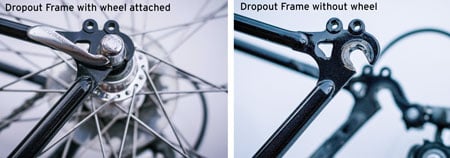
Axle Dimensions
Axle diameter: If you have a thru axle, you'll need to know the axle diameter. Common examples include 12mm (road front, and mountain rear), 15mm (road front and mountain front) and 20mm (mountain front). (Because quick-release skewers are almost all 9mm, diameter isn't a concern with a skewer.)
Axle length: Whether you have quick-release skewers or thru axles, you need to know the internal distance within the frame where the wheel mounts. Common examples include 100 or 110mm (front) and 130, 135, or 142 (rear). Some wheels include adapters to fit a variety of axle lengths.
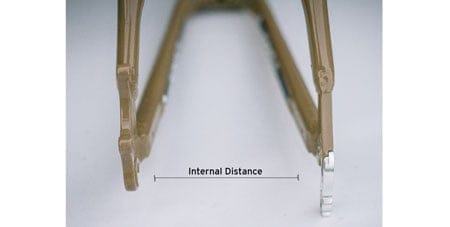
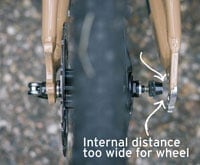
Rear Hub Type
This determines how your rear wheel engages with the cogs in your bike's drivetrain. There are two main hub types:
Freehub: Found on most bikes, a freehub has a spline that precisely fits into the center of your rear cassette. The cassette typically has a lock ring to secure it to the freehub. Your new wheel's freehub must be compatible with your cassette.
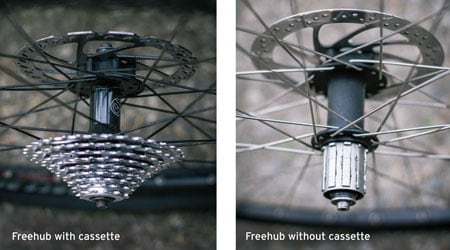
Threaded hub: Found primarily on older 5-, 6- or 7-speed bikes, this type of hub is compatible with a freewheel cluster, a set of rear cogs that attaches by way of simple threads. This style of hub will accept any type of threaded freewheel cluster.
Upgrading Your Bike Wheels
Sometimes overlooked when riders upgrade their bike, a better set of wheels can help you significantly boost performance.
All of the compatibility concerns discussed for wheel replacement also apply to a wheel upgrade.
And, even if you don't plan to do a tire upgrade at the same time, you should inspect your old tires to be sure they don't need replacing.
Here are some of the factors that affect bike wheel quality and cost:
Better materials: Ultralight, ultrastrong carbon-fiber rims can offer a leap in performance and sticker price compared to most alloy rims. Compared to alloys, carbon can be formed into a wider range of shapes while also offering superior strength and stiffness. This lets wheel designers create lighter, stronger or more aerodynamic wheels with the same or lower weight than they can achieve with alloys. Be aware, though, that carbon wheels with rim brakes can be slicker in the rain and run much hotter on long downhill sections than rim-brake alloy wheels.
Better bearings: Bearings don't impact performance much until they start to wear out. When that happens, your wheels turn less efficiently. When you upgrade to a higher quality, pricier wheel, it will likely have better, more durable bearings.
Better hubs (on rear wheels): You can enjoy better pedaling efficiency and greater durability. A wheel with faster hub engagement—meaning your crank travels a shorter distance before the drivetrain kicks in—will make your bike more responsive.
Choosing Bike Wheels for Performance
When upgrading your wheels, you're probably looking for wheels that are lighter, stronger, more aerodynamic (or a blend) based on the type of riding you do. These charts show some of the key areas affected by specific features of your wheels:
Wheel Characteristics for Types of Road Biking:
| Climbing | Racing / speed | Commuting/Touring |
Light | X | X |
|
Strong |
|
| X |
Aerodynamic |
| X |
|
Wheel Characteristics for Types of Mountain Biking:
| All-mountain | Downhill | Cross-country |
Light | X |
| X |
Strong | X | X |
|
Lighter wheels: These pay off when you're climbing. Lighter wheels lower your overall bike weight, meaning you expend less energy to move. A 200-gram savings over your current wheels can provide a noticeable performance boost.
Weight placement on the wheel can also affect the performance of the wheel. Wheels with a greater percentage of their weight at the rim are harder to get moving. On the other hand, wheels with less of their weight at the rim and more of their weight at the hub, will feel more responsive.
Stronger wheels: For some types of riding, strength trumps low weight. Road wheels for commuters and touring cyclists need to handle heavy loads and high mileage.
A stout set of wheels is a must for downhill mountain biking, which involves aggressive riding and big jumps. Happily, lift access makes it easy to transport heavier wheels to the top. All-mountain riding, where descents are earned by climbs, requires wheels that are both light and strong.
There's no universal spec for strength, so you need to pay close attention to clues in the wheel names, material properties and construction details. A higher spoke count makes a wheel stronger. Crossing spokes also increases strength, with spokes that cross more times increasing a wheel's strength even more.
More aerodynamic wheels: Even at speeds as low as 20mph, minimizing wind resistance starts to pay big dividends. So, for all types of road riding, from cruising to criteriums to century rides, upgrading to more aerodynamic wheels makes sense.

You don't need to spend thousands of dollars for full-on disc wheels. Subtler features like a deeper rim profile—meaning the sidewall of the rim is taller—improve aerodynamics, as do bladed spokes. Look for "aero" in either the wheel name or the product features. Be aware, though, that any aero wheel can be more difficult to handle in a crosswind.
Wider wheels: In the past, skinnier wheels and tires were considered more aerodynamic, but air-turbulence studies in recent years reveal that wider tires don't necessarily encounter more wind resistance. Wider tires offer a generally more comfortable and more forgiving ride—and they actually encounter less rolling resistance—so the trend is to go wider these days.
Most wheels will accept a range of tire widths. But if you decide to run wider tires, it's also worth considering wider wheels for a better fit. If you go with significantly wider tires, you'll need to be sure they have enough clearance within your bike frame, too. Ask a bike-shop expert if you're considering significantly wider tires.
Bike Wheel Maintenance
Wheel truing: Truing a wheel involves reshaping it to be perfectly round, removing any bends and tightening all spokes to the correct tension. Wheels should be true out of the box, and wheel truing is part of a standard bike tune-up. Unless you suspect something is off or you hit a really big obstacle, you don't need to have your wheels trued more often than your regular tune-up schedule. If you are a regular bike commuter, have your wheels trued more often, and have your bike maintained more often.
Wheel repairing: If your wheel is tweaked rather than worn out, you can have the shop repair it. Bring the wheel in and the shop staff can help you decide if repair or replacement is the better option.
